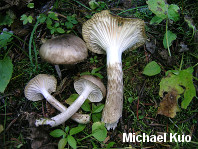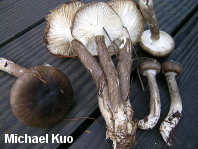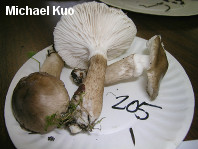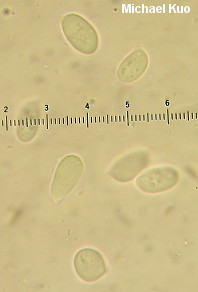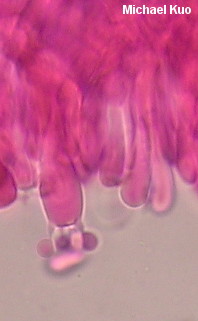| Major Groups > Gilled Mushrooms > Pale-Spored > Waxy Caps > Hygrophorus olivaceoalbus |

|
Hygrophorus olivaceoalbus [ Basidiomycota > Agaricales > Hygrophoraceae > Hygrophorus . . . ] by Michael Kuo Hygrophorus olivaceoalbus belongs to a group of fascinating waxy caps that feature not one but two veils protecting the young gills. The "inner veil" is composed of tiny threadlike fibers, and the "outer veil" is composed of thick slime. When the mushroom approaches maturity the cap expands to break the veils, which then are left to form a sheath around the stem. In Hygrophorus olivaceoalbus the inner veil is brown to grayish brown, and easily seen. As the stem grows, the veil is pulled apart, resulting in stretched-looking concentric bands and, often, a thin and flimsy ring. The outer slime veil quickly dries out in warm conditions. A number of similar species and varieties have been named on the basis of minor differences in physical features; whether or not these taxa are actually phylogenetically distinct has not been investigated, to my knowledge. See Hesler & Smith (1963) and Largent (1985) if you are interested. Description: Ecology: Traditionally thought to be mycorrhizal with conifers, but possibly parasitic on the roots of spruces and other conifers, according to recent investigations (see Lodge and collaborators, 2013); often found under redwood and Sitka spruce on the West Coast, Engelmann spruce in the Rocky Mountains, and spruces or eastern hemlock in the northeast; growing scattered, gregariously, or in small clusters; late summer and fall (over winter in warmer climates); fairly widely distributed in northern and western North America. The illustrated and described collections are from California and Colorado. Cap: 3-12 cm; convex when young, becoming broadly convex or more or less flat; sticky when fresh; with a streaked appearance from stretched-out fibers beneath the slime; dark brown to gray-brown; lighter towards the margin; the margin somewhat inrolled when young. Gills: Attached to the stem or running down it; distant or nearly so; white; waxy; short-gills frequent. Stem: 3-10 cm long; up to 1 cm thick; equal or with a somewhat tapered apex; when fresh sheathed with slime over the lower portion; white at the apex; covered below the slime with brown fibers that stretch out as the mushroom grows and often become disposed as vaguely concentric stripes or bands by maturity; often with a fragile and imperfect or somewhat gelatinized ring; basal mycelium white. Flesh: White; unchanging. Odor and Taste: Not distinctive. Chemical Reactions: KOH negative on cap surface. Spore Print: White. Microscopic Features: Spores 8-13 x 4.5-6 µ; ellipsoid; hyaline in KOH; inamyloid. Basidia 4-sterigmate; to about 55 µ long. Hymenial cystidia absent. Lamellar trama divergent. Pileipellis an ixocutis with clamp connections present. REFERENCES: (Fries, 1815) Fries, 1838. (Fries, 1821; Saccardo, 1887; Kauffman, 1918; Hesler & Smith, 1963; Bird & Grund, 1979; Smith, Smith & Weber, 1979; Largent, 1985; Arora, 1986; Phillips, 1991/2005; Lincoff, 1992; McNeil, 2006; Trudell & Ammirati, 2009; Lodge et al., 2013.) Herb. Kuo 09040604. Herb. DBG RMNP 2008-205, 2009-018, 2009-020. This website contains no information about the edibility or toxicity of mushrooms. |
© MushroomExpert.Com |
|
Cite this page as: Kuo, M. (2014, July). Hygrophorus olivaceoalbus. Retrieved from the MushroomExpert.Com Web site: http://www.mushroomexpert.com/hygrophorus_olivaceoalbus.html |
